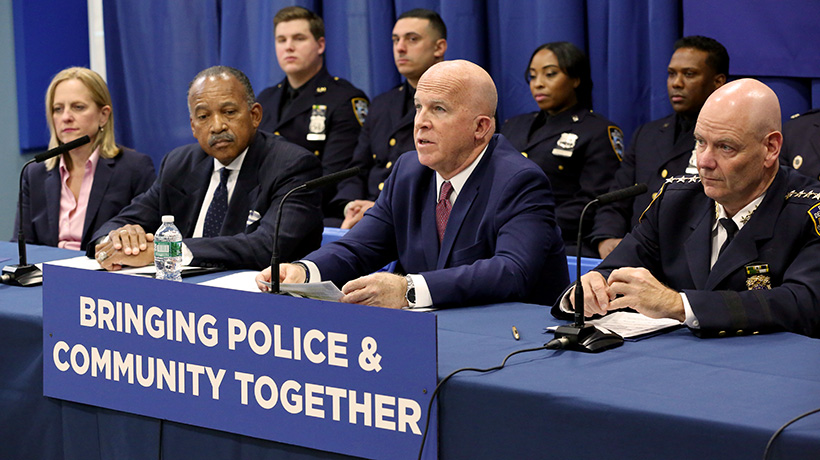Neighborhood Policing Now in Every Neighborhood in New York City
October 22, 2018
Neighborhood Policing is the largest change to the NYPD since CompStat in 1994; Strategic shift to fight crime and solve problems collaboratively with the public
Police Commissioner James P. O'Neill today announced a major milestone in neighborhood policing, the comprehensive crime-fighting strategy built on improved communication between police officers and community residents. The Neighborhood Coordination Officer Program will be launched in the 104th precinct in Queens and the Midtown North Precinct in Manhattan this week, making Neighborhood Policing operational in every residential precinct. Through the implementation of Neighborhood Policing, the NYPD has increased trust and respect with the public while improving crime fighting capabilities.
Police Commissioner James P. O'Neill said, "Our Neighborhood Policing philosophy means we are forging deeper connections with all the people we serve, in every community, by building trust and strengthening relationships. Today's announcement does not mark the end of an effort that began nearly three-and-a-half years ago. In fact, it marks a new beginning. The message is: Public safety is a shared responsibility. This is where we need to be as a police department. And this is where we need to be as a city of 8.6 million New Yorkers and nearly 63 million visitors a year. This is how we are making our way forward — together. It is that credo — that understanding — that is guiding our evolution. And it is how we are continuing to push crime down past already record-lows."
Neighborhood Policing was launched in June 2015, with a pilot beginning in four precincts in May 2015. Today marks the second to last roll-out in the 104 precinct in Queens; later this week the last roll-out will occur in the Midtown North precinct. This will mean the NYPD's operational roll out is complete in 76 precincts as well as each of the nine Police Service Areas that comprise the NYPD's Housing Bureau. One precinct, Central Park Precinct, is not part of the roll-out as it is not residential. Six of the 12 Transit Districts citywide are now NCO Commands. Full implementation in each of the department's 12 Transit Districts is scheduled to take place by the beginning of 2019. The NYPD also launched Neighborhood Policing in New York City schools in the Bronx East sector at the start of the school year.
Neighborhood Policing divides precincts into three, four or five fully-staffed sectors that correspond, as much as possible, to the boundaries of actual established neighborhoods. The same officers work in the same neighborhoods on the same shifts, increasing their familiarity with local residents and local problems. The radio dispatchers, supervisors, and sector officers' work together to maintain "sector integrity," meaning that the sector officers and sector cars do not leave the boundaries of their assigned sectors, except in precinct-wide emergencies. Neighborhood Policing is sufficiently staffed to permit off-radio time for the sector officers, so they are not exclusively assigned to answering calls for service. Their off-radio time is used to engage with neighborhood residents, identify local problems, and work toward solutions. Supporting the sector officers and filling out each sector's team are two officers designated as the neighborhood coordination officers (NCOs). The NCOs serve as liaisons between the police and the community, but also as key crime-fighters and problem-solvers in the sector.
In addition, NCOs host Build the Block meetings in every sector of every neighborhood to meet with constituents to identify the public safety challenges of a specific neighborhood and discuss potential solutions. The meetings are strategy sessions between local police officers and the people they serve, where relationships are fostered, problems and crime are discussed, and a process for feedback is developed. To date, NCOs have held over 1,500 Build the Block meetings to address problems, help fight crime, and build stronger relationships between officers and community members. New Yorkers can find the next Build the Block meeting in their neighborhood at: buildtheblock.nyc.
Since the launch of Neighborhood Policing, crime has continued to fall citywide. Just recently for the first time in a quarter century, New York City did not have a single shooting incident reported during a three day weekend period. Neighborhood Policing continues to be a paradigm shift for the NYPD in its goal of combining greater police community relations while continuing to drive down crime spikes, in real time, wherever and whenever it arises.





